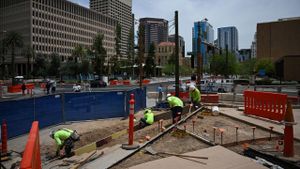The US Secret Service has recently rolled out its latest security measure at Mar-a-Lago—a robotic dog named Spot, developed by Boston Dynamics. This fascinating four-legged machine is more than just tech flair; it symbolizes the increasing integration of advanced robotics within security protocols.
Spot is stationed to patrol the expansive grounds of the former president's resort located in Palm Beach, Florida. With videos of Spot making the rounds on social media, reactions have varied from TikTok users adoring its qualities to others branding it as eerily intimidating. Yet, behind the light-hearted banter, the mission is serious—ensuring the safety of the president-elect. Secret Service chief of communications Anthony Guglielmi has emphasized, "Safeguarding the president-elect is a top priority."
Equipped with advanced surveillance capabilities, Spot operates either autonomously or via remote control, following designated routes. It’s void of weaponry, but the message emblazoned on its legs—'DO NOT PET'—certainly evokes caution, considering it traverses such high-stakes areas.
The deployment of Spot is primarily fueled by recent threats against Trump, including two assassination attempts this year. The first attempted attack unfolded during a rally in Pennsylvania, followed by another at Mar-a-Lago itself. Such alarming incidents, detailed by former Secret Service agent Ron Williams, have called for heightened security measures, prompting the agency to embrace what he describes as "long overdue" technology.
Spot's enhanced operational scope offers distinct advantages over human security staff. Unlike traditional guards, robotic dogs like Spot can cover expansive properties quickly and collect more comprehensive surveillance data. Boston Dynamics has confirmed the use of these robots as part of Trump's security team, aligning with growing global trends of using similar technologies for both military and civilian protective services.
From bomb disposal units in Pennsylvania to reconnaissance missions overseas, robotic systems are swiftly becoming pivotal tools for safety and security. With Parkland High School and various law enforcement agencies integrating robotic dogs, the sentiment appears clear: robotics can bring efficiency to security tasks.
While the Secret Service has been tight-lipped about specific operational capabilities, experts share insights about Spot’s features. It is capable of capturing 3D images of its environment, backed up by thermal imaging sensors and observational cameras. Indeed, Spot's design allows it to navigate tight spaces, climb stairs, and even open doors, making it uniquely qualified for patrolling expansive estates like Mar-a-Lago. The emergency adaptations these robots can provide are invaluable, especially when conventional measures appear insufficient.
Conversely, experts like George Mason University's engineering professor Missy Cummings remind us of the limitations inherent to Spot. She pointed out its need for human guidance to maneuver and terminate operations effectively, likening its functioning to the conception of advanced driver-assistance technology. Just as one wouldn’t rely solely on their vehicle’s latest safety features, the same applies to these robotic security systems.
Interestingly, there are discussions about weapons integration within robotic systems—an idea attracting both imagination and concern. While Spot itself lacks armaments, some military experimental models are being tested with firearms, casting the future of robotic protection and enforcement in even starker light. The unique design of Spot—even though it may be impeded by simple distractions such as sprays—could transform general notions of threat detection.
Notably, the crossover of robotic dogs from high-profile secured locations to local street services is tangible. Roofed by rising public interest, Spot is also present with police departments on factory floors, performing inspections, and emergency operations. The New York Police Department had even adopted similar robots to bolster community safety, illustrating the broadening applicability of this technology.
At the end of the day, the deployment of robotic dogs like Spot does not signal the obsolescence of human agents. Instead, as Melissa Michelson, political scientist, aptly states, this tool enhances the existing frameworks, helps teams to cover more ground effectively, and adds another layer of protection for those at risk.
With the combination of traditional security measures alongside robotics, the potential for innovative safety protocols shines brightly. Whether it's through giving agent teams more oversight or responding to incidents, technologies like Spot promise to play integral roles. A move toward the future, these developments may not only change security operations but also influence broader discussions about privacy, technology, and ethics within such powerful institutions.



